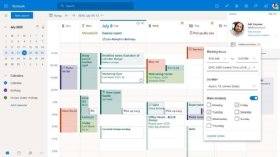
daniilvolkov - stock.adobe.com
Microsoft addresses workforce patterns using Teams, LinkedIn
A survey of the Microsoft workforce found that employees planned to be back in the office more than their managers expected. The discrepancy means companies need to be flexible.
Microsoft added features to its collaboration software Teams, video conferencing hardware Teams Rooms, and online business service LinkedIn to bridge the divide between managers' and employees' expectations on returning to the office.
In an intra-company study published this week, Microsoft found that employees want to come back to work more often than managers expect. The discrepancy, which Microsoft believes can be extrapolated to other tech companies, could lead to a lack of resources and office space if companies downsize too much in preparation for a hybrid workforce.
While 8% of Microsoft employees said they plan to go to the office every day, only 1% of managers expect them to do so. A plurality of employees, 48%, said they planned to come in three to four times per week, while only 28% of managers expected the same. Thirty-one percent of employees wanted to work in the office one to two times per week, versus 25% of managers with the same expectation.
Dealing with the discrepancy will require corporate flexibility, Microsoft CEO Satya Nadella said in a joint video with Ryan Roslansky, CEO at Microsoft-owned LinkedIn.
"In order to discern what flexibility is needed, you need to have that compassion, that empathy as a leader," Nadella said.
But Brian Kropp, chief of research in Gartner's human resource practice, said corporate flexibility could solve one problem and create another.
"When everyone is in the office, you have to have the same real estate footprint as you did before," Kropp said. Letting people decide when they want to come in "gives people the most flexibility."
"It gives you the most opportunity to decrease the size of your office footprint and save on real estate costs," he said.
Tatiana Frierson, CEO of human resources software company Inspirus, is undecided on splitting employees' time in the office and at home. A company survey found that employees preferred to work two or three days virtually after the pandemic. Most did not want to work entirely remotely.
"People miss the physical connection," Frierson said. "I don't plan to mandate it either way at this point. Flexibility is king right now."

But the flexible approach is also the hardest to manage, Kropp said. Employees need to feel that staying home is akin to coming into the office.
That's where Microsoft's new features come in.
In Teams Rooms, Microsoft added a camera that uses AI to track the speaker and separate speakers in one room into individual panes on the screen. Last year, Neat introduced a similar option called Neat Symmetry and Zoom introduced Smart Gallery in July. These changes are available in Teams Rooms now.
LinkedIn added an option for employers to say how often they expect workers in the office, and for employees to signify how often they prefer to come in.
"Over time, it's going to settle in a great spot … where people's values align with the companies they work for," Roslansky said. "But it's going to take us a while to get there."
Early next year, Microsoft will add features to its email client Outlook that will make it possible to see when, where and how people are joining a meeting. An RSVP option will let employees signify if they are attending in person, which Microsoft said will make it easier to prepare conference rooms for the right amount of people.
Another feature expected in early 2022 is an AI "speaker coach" that will tell employees when they are interrupting and suggest changes to their speaking pace during presentations.
"The Microsoft announcements are focused on blurring the lines between in-office and remote employees," said Irwin Lazar, an analyst at research firm Metrigy. "These approaches by Microsoft, as well as its competitors, should help foster meeting equity."
Maxim Tamarov is a news writer covering mobile and end-user computing. He previously wrote for The Daily News in Jacksonville, N.C., and the Sun Transcript in Winthrop, Mass. He graduated from Northeastern University with a degree in journalism. He can be found on Twitter at @MaximTamarov.





